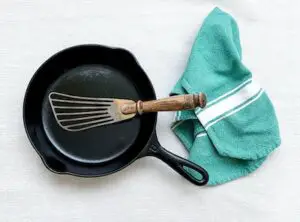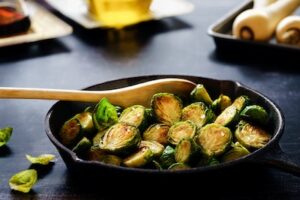8 Tips for Cleaning an Iron Skillet
There aren’t many kitchen utensils and cookware quite as notable as the cast iron skillet. With several different ways to cook good food, the iron skillet comes with rules on usage, seasoning, and is also famed for the “do not use soap rule.” However, sometimes, rules are meant to be broken. If you are someone who needs to know how to clean your cast-iron pan, here are 8 helpful tips on cleaning, drying, and priming the pan for its next use.
Perhaps the most important rule to follow when deciding to clean your iron skillet is to wash it by hand – beyond that, you have many different options. After washing, however, drying the pan immediately afterward is also an important step in maintaining the skillet.
In this post, we will share 8 tips for how to clean an iron skillet including:
 Soapy Water and Srub Sponge
Soapy Water and Srub Sponge- Pan Scrapers with Soapy Water
- Chain Mail Scrubbers Without Soap
- Salt Scrub on Heat
- Rust Erasers
- Hot Oil
- Cornmeal
- Baking Soda
If you’d like to learn more about how to use these methods to clean your pan and the best ways to maintain it, keep reading.
Soapy Water and a Scrub Sponge
While the age-old wisdom for cleaning cast iron skillets involves not using soap, the real thing to avoid is rust. Soap will not hurt the pan or the seasoning coating it – water will. However, that doesn’t mean you shouldn’t use any water, you just need to use it well.
Taking a little bit of water and soap, lightly scrub the pan with a non-scratch sponge to remove the grease and dirt. Use warm water and don’t be afraid to wash the pan well – the trick to maintaining the seasoning and integrity of the pan has more to do with what happens after you wash it (we’ll explore this later).
Pan Scrapers With Soapy Water
In much the same way as using a scrub sponge, pan scrapers are also a good option. When you have stuck-on food, pan scrapers can be useful to remove the tougher areas and clean without diminishing the seasoning.
If you are someone who still believes that soap is not good for your cast-iron cookware, you can still use the pan scrapers without soap – just scrub like normal.
Chain Mail Scrubbers Without Soap
Those old-fashioned chain mail scrubbers may look a little harsh for scrubbing your pan, but if you’re gentle, using them to get rid of the tougher, burnt-on bits can be useful. You don’t need to use soap with these, simply run a little bit of warm water to coat the pan and scrub.
Salt Scrub on Heat
If you’ve got a lot of left-over grime and burnt-on food in the pan, pour some salt into it and set the pan over high heat. As the leftovers soften, take some paper towels and rub out the charred bits from the pan.
Salt acts as an abrasive that doesn’t mess with the seasoning and the heat makes the food easier to scrub away. After you remove the tougher bits, you can rinse out the salt and wash the pan with warm soapy water and follow through with the drying of the pan.
Rust Erasers
Rust has been established as the real culprit to ruining your cast iron skillet – but there are still ways to clean it up and make it good as new! If water has soaked into the pan and caused some rust, rust erasers can help bring the pan back to life.
Use warm, soapy water and a tough rust eraser. Scrub thoroughly with the eraser, rinse and dry the pan afterward. Take some cooking oil and apply a thin layer to the pan. Place the pan in the oven upside down on the top rack at 450-500 degrees for one hour.
You should see the removal of the rust and the ability to build the seasoning back with a clean, fresh start for the pan.
Hot Oil
The easiest and most basic way to clean your cast iron skillet is to use hot oil. Take a tablespoon of oil and pour it into the pan with the burner on medium-high. Let the oil heat up and sizzle in the pan for about 2-3 minutes. You will start to see the food loosen and start swimming on the surface.
When the food has lifted, you can turn the burner off and let it cool before wiping it out with either a paper towel or dishrag. With hot oil, you can avoid using water and soap and still end up with a clean, well-seasoned cast iron skillet.
Cornmeal
Like salt, cornmeal can be used as an abrasive to help clean your cast iron skillet. Take ¼ cup of cornmeal and pour it into the pan. Use a dry sponge to scrub out the tough food bits, dump it, and repeat 2-3 times until clean.
By using an abrasive like cornmeal, you can avoid having to use soap and water if that still makes you skittish.
Baking Soda
There is not a whole lot that baking soda isn’t useful for, and cleaning a cast iron skillet is another one. Start by filling up your pan with water, enough that it completely covers the areas with burned-on bits. Turn your burner on high and let the water come to a boil. With two tablespoons of baking soda, stir the mixture for a few minutes.
Once you let the mixture move, turn off the burner and dump it out and start scrubbing the bottom and sides of the pan with a sponge. You can repeat this process until the pan is clean, or you feel satisfied.
Maintaining Your Iron Skillet After Cleaning
 Once you have scrubbed your pan and cleaned it to your satisfaction, dry it immediately! Just like there are several different ways to clean the pan, there are also several ways to dry it.
Once you have scrubbed your pan and cleaned it to your satisfaction, dry it immediately! Just like there are several different ways to clean the pan, there are also several ways to dry it.
You never want to let it drip dry because that invites rust to take over, instead, do one of the following.
Use a dark dish rag to thoroughly wipe down the pan and dry it, or put the cleaned pan on a low flame until it’s dry.
The best thing to do would be to wipe it dry, and then place it over a flame – this ensures the pan is completely dry and helps season the pan at the same time.
After your cleaned pan is completely dry, reseason and prime it for the next use. Use some unsaturated cooking fat, like canola, vegetable, or corn, and rub the pan all over, very lightly. Be sure to buff any visible greasiness so that the skillet doesn’t look like you oiled it at all.
Put the pan back on the burner on high heat and let it sit for a few minutes until it’s hot and lightly smoking – then put it away and it’s ready for the next time.
We hope that, with these tips, you are ready to venture into the world of cast iron cooking! Cast iron skillets are used by chefs and home cooks around the world. Some of the best iron skillets are made in India! This is a great, versatile tool to add to any kitchen.
Related Questions
What Does It Mean to Season Your Cast-Iron Skillet?
Seasoning a cast iron skillet is simply oil that is baked into the cast iron through polymerization. The seasoning creates a natural, easy-release cooking surface and prevents your pan from rusting. Cooking with your cast-iron skillet will build this layer, giving it a better cooking surface and more flavor over time.
Polymerization is a process that takes oils and fats that are heated at a high enough temperature, taking them from wet liquids and turning them into a slick, hardened surface. The surface is then bonded to the iron, keeping it from rusting and making it an easier-to-use cooking surface.
Black Flakes Are Coming Off My Pan – What Does That Mean?
If black flakes start coming off of your pan, it simply means that the seasoning hasn’t bonded with the iron. Though this isn’t what you want, it’s not a bad thing, just scrub the pan, rinse, dry, and rub it with oil. Using the oven to season the pan may help bond it to the iron more strongly.
What Kind of Foods Should I Not Cook in my Cast-Iron Skillet?
 You should avoid highly liquid and extremely acidic foods when using an iron pan. Small amounts are okay, but during extended periods of cooking, the acid and liquid can eat away at the seasoning of your pan. Once your seasoning is well established, you can add these foods cautiously.
You should avoid highly liquid and extremely acidic foods when using an iron pan. Small amounts are okay, but during extended periods of cooking, the acid and liquid can eat away at the seasoning of your pan. Once your seasoning is well established, you can add these foods cautiously.
Why Did People Say Not to Clean Your Iron Skillet With Soap?
There are two main reasons why the myth started about not using soap to clean your iron skillet. First – the soap would effectively wash away the oil that was used to create the nonstick surface of the pan. Second, soap is not an efficient cleaner on cast iron. The truth is, not using soap is just a myth!
Most professional cooks/chefs will still choose not to use soap when cleaning their iron skillets, but the truth is that soap will not hurt the pan as long as you dry and oil the pan effectively after cleaning it.

